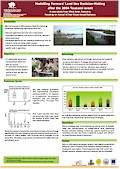| Poster |
 |
|
| Title | Modelling Farmers | | Author | Dian Yusvita Intarini, Carsten Marohn, Gerd Dercon, Desi Suyamto, Betha Lusiana, Laxman Joshi, Meine van Noordwijk and Georg Cadisch | | Year | 2008 | | Publisher | World Agroforestry Centre - ICRAF, SEA Regional Office | | City | Bogor, Indonesia | | Call Number | PO0133-08 |
|
| Abstract: |
| The earthquake and Tsunami of December 2004 changed coastal land in West Aceh in Indonesia - land subsidence, ground water salinity and changed soil properties by mud deposits. A study was undertaken in 2007 to understand farmers' land use-related decision making after the Tsunami and the principal driving factors influencing these decisions. Four objectives were set up: (i) to identify land use dynamics from before and after the Tsunami; (ii) to understand biophysical and socio-economic factors influencing farmer's decisions on land use; (iii) to prospect a baseline land use sequence in the next three decades using a simulation model; and (iv) to explore alternative future land use trajectories through scenario studies using a simulation model.
Socio-economic and biophysical data related to farmer's decision making were collected through in-depth interviews at a household level. Selecting households, purposive random sampling was applied along existing transects used for earlier studies. The results indicate some obvious change in land use by the farmers in the research study area. Rubber gardens have been converted to housing settlements. The affected agricultural land forced farmers to find other arable land for cultivation. Farmers also adopted new crops based on value and profit in future. In general, farmers in the study area still cultivate paddy, other annual crops, coconut and rubber. Land use has not changed significantly since the Tsunami, but rather shifted in terms of size and location of agricultural plots. Reduced labour force led to a shift from annual crops to perennial crops such as rubber and cocoa. Farmers also now prefer longer term crops to short-term crops.
The major driving factors in farmers’ decision making process are labor and financial capital. The on-going relief and construction activities also influenced farmers' allocation of time on on-farm and off-farm activities. Other factors include household subsistence levels, education of children, religious inclination and risk management strategies (such as climate, seasons and natural disasters). |
|
|
Download file(s): Click icon to download/open file.
|
| |
File Size |
Description |

|
295 KB |
Softcopy |
|
|
GRP 6: Developing policies and incentives for multifunctional landscapes with trees that provide environmental services
|
| Viewed in 2126 times. Downloaded in 419 times. |